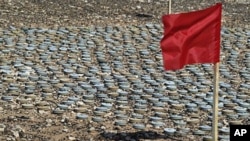As the fighting rages in Libya, human rights groups are looking to a longer term consequence of the war - the use of landmines.
The hazards of mortar fire and rocket attacks are bad enough, but Libyans must now face the renewed problem of anti-personnel and anti-vehicle landmines.
There are reports that both sides in the conflict have been using them. Human Rights Watch accused government troops of placing mines last month south of Ajdabiya. And while a rebel commander vowed his forces would not use landmines, over the weekend, journalists reported seeing rebels burying the devices near Ajdabiya's eastern gate.
Further north, Benghazi driver Tarek el Mehadawi said he is not so worried about the area around his hometown, but is concerned about other parts of the country.
Mehadawi said areas around Sirte, Libyan leader Moammar Gadhafi's hometown, or the besieged city of Misrata would be likely places for the hidden munitions, but that it's very difficult to know their precise location.
Which is what makes the weapons so deadly. Most of the victims of landmines are civilians. In Libya, they would be the farmers and shepherds who walk the areas close to the roads where the mines are laid.
For Libyans, the problem is not new. Nearly 70 years after the armies of Britain and Germany fought pitched battles across North Africa, landmines from World War II remain buried beneath the sands.
Simon Brooks, head of the Benghazi mission of the International Committee of the Red Cross, said the solution is two-pronged.
"Right from the period of the second world war, up to the present day, this country has a significant weapons contamination issue. And obviously, this is an area in which the ICRC has developed a particular specialty, really on two fronts. One is the public education, the public awareness, and we would work very closely with the Libyan Red Crescent to respond to that."
Brooks said the second part is getting rid of the weapons, a long and arduous process, that they will undertake with authorities in Benghazi.
"We need to coordinate, obviously with them, but also with other actors who would come here, because we wouldn't pretend that the dimensions of this problem is such that we would be able to get on top of it ourselves. And so, it's going to take an immense amount of effort. It is going to take a long-term engagement on our part."
There is perhaps a third step - stopping their use. Most countries do not allow anti-personnel mines, but Libya, along with the United States, China and Russia, has rejected a treaty to ban them.













